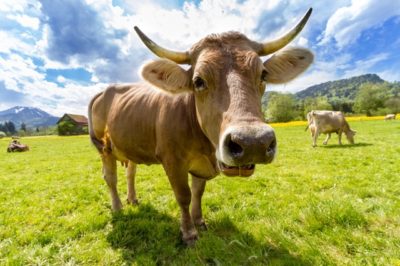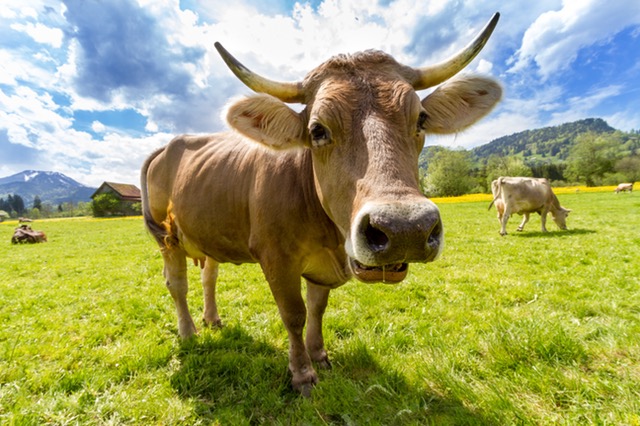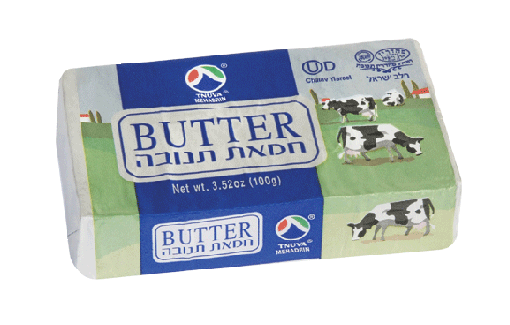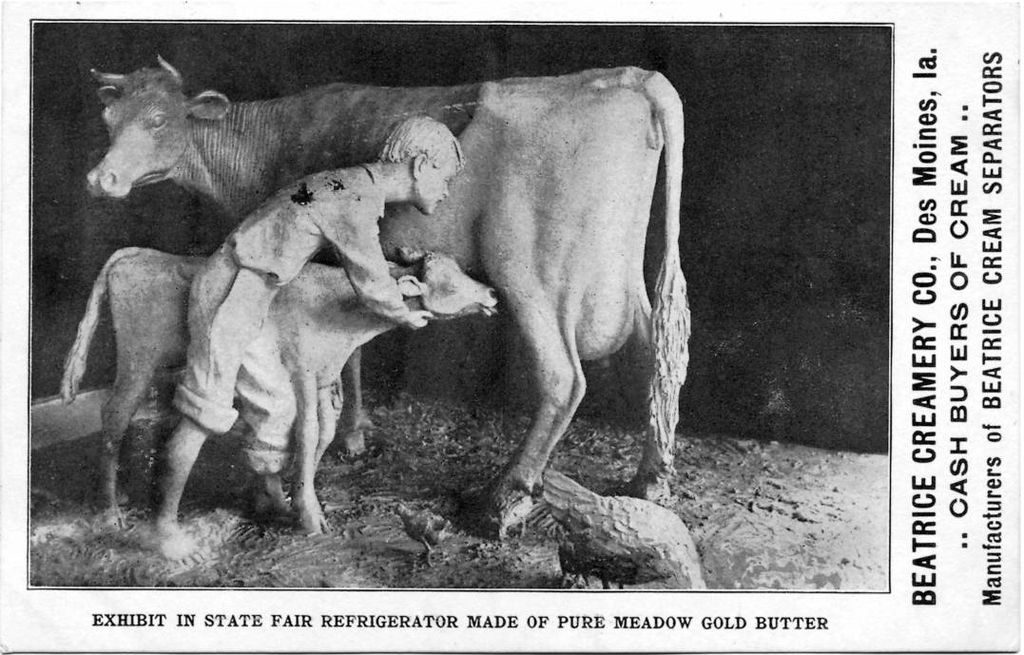Why you want grass-fed butter and where to find it in Israel


One of the important foods that people often search for is butter (חֶמאָה – chem’ah) from pastured cows because it is a rich source of Vitamins A, D, and K2, as well as many other nutrients. The color of the butter ranges from pale to deep yellow depending on the season, the soil, and the percentage and type of feed that the animals may receive in addition to grass. (A deeper color is indicative of greater amounts of carotenoid pigments from increased amounts of Vitamin A.) Butter from cows grazing on fast growing spring and fall grass is the most nutritious. In fact, Weston Price noted a reduced incidence of heart attacks among people who eat butter made from cows feeding on spring and fall grass.
In 1930, Dr. Weston Price published an interesting paper in the Journal of the American Dental Society. For years, Dr. Price had been analyzing the amounts of vitamin A and vitamin D in butterfat. He noted that these nutrients were most plentiful in the spring and fall, when cows had access to rapidly growing green grass. During the dry winter and summer months, levels of these vitamins in butterfat declined or disappeared completely.
Dr. Price also tabulated the number of deaths from heart attacks in local hospitals. When he plotted these two variables against time on the same graph he found that deaths from heart disease were inversely proportional to the vitamin content in the butter. In other words, when nutrient levels were high, deaths from heart disease were low; and when nutrient levels were low, deaths from heart disease were high. He found this pattern in many different localities, even in areas in the far north where there was only one vitamin peak, in midsummer, due to the short growing season.[1]
Further evidence of the benefits of consuming dairy from pasture raised cows comes from a study done in Costa Rica, where cows are grazed. Here, too, researchers found a lower incidence of heart attacks in people who drank milk from cows that were pastured.
Earlier experiments have shown that cows on a diet of fresh grass produce milk with five times as much of an unsaturated fat called conjugated linoleic acid (CLA) than do cows fed processed grains. Studies in animals have suggested that CLAs can protect the heart, and help in weight loss.
Hannia Campos of the Harvard School of Public Health in Boston and her colleagues found, in a study of 4,000 people, that people with the highest concentrations of CLAs — the top fifth among all participants — had a 36 percent lower risk of heart attack compared to those with the lowest concentrations.
Those findings held true even once the researchers took into account heart disease risk factors such as high blood pressure and smoking.
The new findings suggest that CLA offers heart-healthy benefits that could more than offset the harms of saturated fat in milk, Campos said. [2]
“Because pasture grazing leads to higher CLA in milk, and it is the natural feed for cattle, it seems like more emphasis should be given to this type of feeding,” she told Reuters Health by email. [3]
In addition to the above, butter contains a number of other health promoting constituents such as: lecithin which helps in the proper assimilation of fats; selenium, Vitamin E, and cholesterol which are antioxidants; short and medium chain fatty acids which have anti-tumor and other beneficial properties; iodine which is important for the thyroid; glycospingolipids, a particular type of fatty acid which protects against gastrointestinal infections; and other critical nutrients. [4]
In Israel, despite its dairy industry being considered one of the best and most sophisticated in the world, with cows specifically bred to produce copious amounts of milk, domestic butter is white. This is because Israeli dairy cows are never pastured (beef cattle are).
“While dairy cows elsewhere in the world are able to graze in natural pastures, Israeli cows cannot be left out due to the small size of the country and climate. They are fed with locally grown irrigated forage supplemented by imported grain.” [5]

Joshuah Miron who heads the Ruminant Sciences Department and oversees the health and welfare of Israel’s Volcani Center’s herd of 230 dairy cows, says that:
… Israel can grow only 30 percent of the cow’s diet. The rest has to come from somewhere. If the rest is imported, then the price of milk would be very high. Grain costs $340 per ton. Just to feed them, we couldn’t support our cows.
The Volcani Center came up with a nutritious and earth-friendly solution: using some 630,000 tons of wet vegetarian byproducts from the olive oil and food production industries to feed its dairy cows. Otherwise, these byproducts would be treated as waste and taken to the desert and buried… [6]
And according to this recent article, Tnuva (the major dairy company in Israel) has begun giving some cattle feed containing flax which they say improves the animals’ health, as well as their milk’s nutritional profile which is rich in omega 3 fatty acids. It is sold under the brand name Chalav Hameshek.
In any case, it is apparent that the nutrition they receive is not the same as that of their pastured counterparts.

European and other countries (except the US) primarily pasture their dairy cattle, as is evident by the yellow color of the butter. Countries with more temperate climates tend to keep their cattle out to pasture most of the year, while other countries bring their cattle indoors during the winter months. Other circumstances might also mitigate grazing cattle. One company, whose yellow butter is sold in Israel, explained that their butter is produced with milk from several farms including some that are too far from pasture land and are not able to graze their cattle. However, if the ingredient list does not include coloring and the butter is yellow, you can be sure that it has a healthier nutritional profile than white butter.
Fortunately, Israeli consumers interested in purchasing yellow butter from pastured cows can find what they are looking for. The dairy case in many Israeli supermarkets contains both domestic and imported butters, and consumers can find naturally yellow Makabi and Beurre De Normandie from Makabi (chalav Yisrael), Lurpak, Elle & Vire, President, Chemah Hollandit, Chemah (Willi Foods), and other butters (of varying shades, kosher supervision, and prices) that are imported from France, Denmark, Belgium, Germany, and Holland. [7]
To find the stores near you that carry yellow butter call: President 03-681-4006, Makabi (cholov Yisrael) 02-583-8368, Lurpak 08-932-1000, Champion 052-249-8865, Elle & Vire 1-800-504-050, Shufersal Hollandit, and Willi Food (cholov Yisrael) 08-932-1017.
American consumers might be interested in these surveys of the best butters available in the States: 30 Great Butters and Butter Tasting.
Sometimes making purchasing decisions based on price is inconsequential and we can feel comfortable buying the less expensive product. Since the domestic butters tend to be less expensive than the imported ones, it may be tempting to purchase the cheaper item in this instance, too. However, as we now know, this is not the case with butter.
For a more detailed discussion of imported European butters in Israel go here. Local (in Israel) contact information for some of the companies selling imported butters can be found here.
Notes:
[1] What causes heart disease?
[2] For information on the benefits of saturated fats see here.
[3] Is milk from grass-fed cows more heart-healthy?
[4] Why butter is better
[5] The inside story of Israel’s dairy industry
[6] Record making milkers
[7] Champion butter from Ireland, which has been a favorite in many Israeli households that consider it to be superior to the other imported butters, is currently unavailable.
Related articles:
Eating a Weston Price diet in Israel – is it possible?
Related links:
How yellow my butter
Weston Price Trifold butter brochure
How to make butter (and cultured butter!)
Is all butter created equal?
Where to find grass-fed butter (in the US)
Great article. That’s why I don’t like the Israeli butter LOL Very bland. If it weren’t for the German one I get from Tiv Tam, I don’t know what I’d do.
Supher Sol did sell the French & Irish one when I first got here, then they removed them & replaced the French one with the same company, but I think it was only 10% butter & the rest who knows b/c I couldn’t read it. I was pissed to say the least.
And Tiv Tam amazingly doesn’t charge a lot for that butter, only 7+ ILS.
Which supermarkets stock these butters?
Hi Shiran,
I just updated the post to include the phone numbers for those brands that carry yellow butter in order to find out where they are sold near you.
Great article. thank you 🙂
The butters you call “yellow butters” are all grass fed? Not sure there is such a concept in France. I searched for grass fed butter Elle et vire and there was no result.
Hi Francoise,
Thanks for asking. European butters, in general, are from predominantly grass-fed, if not exclusively grass-fed, cows. That and the yellow color of the butter (which does not have any additives in the ingredients, particularly those that would impart color) indicate that the butter is from grass-fed animals. If you look at Tnuva butter, you will see the difference in color. I have also spoken to some other companies, where this was confirmed. The Normandy region of France, where this butter comes from, is also known to be particularly fertile and the milk produced there of good quality.
However, I did write to the company asking them to confirm this. If/when I hear back from them I will update the comments and post.
BTW, I would be careful about purchasing other Elle & Vire products since they use UHT (Ultra high temperature) pasteurization (even on their yogurts) for other products so they will last on the shelf a very long time. This ruins the quality of the product, destroying important nutrients. They are no longer the wholesome, nutrient dense products they once were. What a shame!
Caryn, can you please update on your latest favorite (grass-fed) butters that you’ve been consuming lately?
Cant find good butters that are grassfed lately..
Hi Alex,
I will try to do that shortly. Did you try calling any of the numbers listed to find out where they are sold?
Hi,
I was wondering what you know about the עלמה brand of butter which I’ve seen lately. It’s imported from Poland; is it a better option than the local butter?
And is there a difference between תנובה and טרה?
I think I’ve purchased עלמה already. I haven’t researched that one particularly, but from the other research I’ve done, it seems that most other countries, besides the US (non-organic) and Israel, have grass-fed butter. The animals may be partially grass-fed, depending on the season and other factors. As long as the ingredients don’t have added color, I go by color and taste. Any imported butter, from what I’ve seen, is better than local butter.
I don’t know about differences between תנובה and טרה. I’ve never looked into them.
This is quite an informative article on grass-fed butter and its sources in Israel. I didn’t know the difference between different countries’ cattle and the manner they allow free-roaming depends on the location.
I’m so glad you found this article helpful. I really appreciate your commenting.